
Poeciliidae are a family of freshwater ray-finned fishes of the order Cyprinodontiformes, the tooth-carps, and include well-known live-bearing aquarium fish, such as the guppy, molly, platy, and swordtail. The original distribution of the family was the Southeastern United States to north of Río de la Plata, Argentina, and Africa, including Madagascar. Due to release of aquarium specimens and the widespread use of species of the genera Poecilia and Gambusia for mosquito control, though, poeciliids can today be found in all tropical and subtropical areas of the world. In addition, Poecilia and Gambusia specimens have been identified in hot springs pools as far north as Banff, Alberta.

Eagle is the common name for the golden eagle, bald eagle, and other birds of prey in the family of the Accipitridae. Eagles belong to several groups of genera, some of which are closely related. True eagles comprise the genus Aquila. Most of the 68 species of eagles are from Eurasia and Africa. Outside this area, just 14 species can be found—two in North America, nine in Central and South America, and three in Australia.

Clupeiformes is the order of ray-finned fish that includes the herring family, Clupeidae, and the anchovy family, Engraulidae and sardines. The group includes many of the most important forage and food fish.

Lake Tanganyika is an African Great Lake. It is the second-largest freshwater lake by volume and the second deepest, in both cases after Lake Baikal in Siberia. It is the world's longest freshwater lake. The lake is shared among four countries—Tanzania, the Democratic Republic of the Congo, Burundi, and Zambia—with Tanzania (46%) and the DRC (40%) possessing the majority of the lake. It drains via the Lukuga River into the Congo River system, which ultimately discharges at Banana, Democratic Republic of the Congo into the Atlantic Ocean.
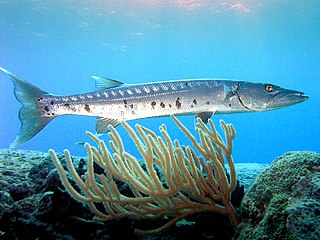
A barracuda is a large, predatory, ray-finned, saltwater fish of the genus Sphyraena, the only genus in the family Sphyraenidae, which was named by Constantine Samuel Rafinesque in 1815. It is found in tropical and subtropical oceans worldwide ranging from the eastern border of the Atlantic Ocean to the Red Sea, on its western border the Caribbean Sea, and in tropical areas of the Pacific Ocean. Barracudas reside near the top of the water and near coral reefs and sea grasses. Barracudas are often targeted by sport-fishing enthusiasts.

Oreochromis is a large genus of oreochromine cichlids, fishes endemic to Africa and the Middle East. A few species from this genus have been introduced far outside their native range and are important in aquaculture. Many others have very small ranges; some are seriously threatened, and O. ismailiaensis and O. lidole possibly are extinct. Although Oreochromis primarily are freshwater fish of rivers, lakes and similar habitats, several species can also thrive in brackish waters and some even survive in hypersaline conditions with a salinity that far surpasses that of seawater. In addition to overfishing and habitat loss, some of the more localized species are threatened by the introduction of other, more widespread Oreochromis species into their ranges. This is because they—in addition to competing for the local resources—often are able to hybridize.

Sarotherodon is a genus of oreochromine cichlids that are native to the northern half of Africa, with a single species, S. galilaeus, also ranging into the Levant. A couple of species from this genus have been introduced far outside their native range, and are important in aquaculture. Most other species have small ranges and some are seriously threatened. They mainly inhabit fresh and brackish water, but a few can live in salt water. Species in this genus, as well as those in several other oreochromine and tilapiine genera, share the common name "tilapia" and historically they were included in the genus Tilapia.
Collared wrigglers are perciform fishes in the family Xenisthmidae. They are native to the Indian and Pacific Oceans, where they are mostly reef-dwelling.
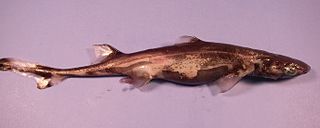
Etmopterus is a genus of lantern sharks in the squaliform family Etmopteridae. They are found in deep sea ecosystems of the Atlantic, Indian and Pacific Oceans.

Haplochromis is a ray-finned fish genus in the family Cichlidae. It has been used as the default "wastebin taxon" for Pseudocrenilabrinae cichlids of the East African Rift, and as such became the "largest" fish "genus". Many of these cichlids are popular aquarium fishes; like similar Haplochromini they are known as "haplos", "happies" or "haps" among aquarium enthusiasts.
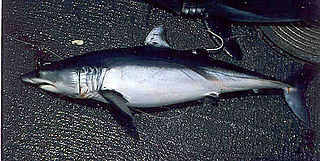
Isurus is a genus of mackerel sharks in the family Lamnidae, commonly known as the mako sharks. They are largely pelagic, and are fast, predatory fish capable of swimming at speeds of up to 50 km/h (31 mph).
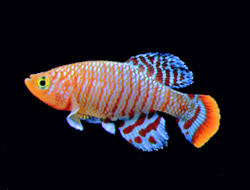
Nothobranchiidae are a family of bony fishes containing roughly 300 species, also known as African rivulines. They are small killifish, usually measuring about 5 centimetres (2.0 in). They are limited to Africa, living in fresh water but being also somewhat salt-tolerant. They are also found in muddy or brackish water. Some species are kept as aquarium pets. They have frilly fins and many are brightly colored. They were formerly included in the family Aplocheilidae ; a return to that broader family has recently been suggested.

Ochthera is a genus of flies in the family of shore flies (Ephydridae). The genus is distinctive because of the swollen raptorial forelegs. The larvae are predaceous on midge larvae while the adults feed on midges and mosquitoes. The genus is found around the world with about 37 species. The species Ochthera chalybescens has been shown to prey on African malaria vectors.
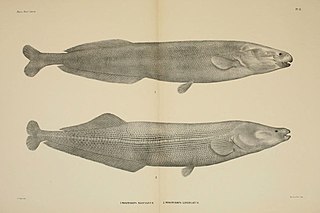
Mormyrops is a genus of weakly electric fish in the family Mormyridae from freshwater in Africa. They are characterized by an elongate head measuring twice as long as high, and no teeth on the palate or the tongue. The genus includes the largest member of the mormyrid family, the cornish jack at up to 1.5 m (4.9 ft) in length.

Fundulopanchax is a genus of killifish living in near-coastal fresh water streams and lakes in Western Africa. All species were previously biologically classified as members of the genus Aphyosemion, with the exception of Fundulopanchax avichang, F. gresensi and F. kamdemi, which were all scientifically described after the major revision of the Aphyosemion complex.
John Ernest "Jack" Randall was an American ichthyologist and a leading authority on coral reef fishes. Randall described over 800 species and authored 11 books and over 900 scientific papers and popular articles. He spent most of his career working in Hawaii. He died in April 2020 at the age of 95.

Sebastes polyspinis, the northern rockfish, is a species of marine ray-finned fish belonging to the subfamily Sebastinae, the rockfishes, part of the family Scorpaenidae. It is native to the waters of the northern Pacific Ocean.

Callopanchax occidentalis is a species of killifish in the family Nothobranchiidae. It is endemic to Sierra Leone and western Liberia.
Claus Herluf Stenholt Clausen was a Danish ichthyologist, known for his work on the river fish of West Africa. Although often cited as H. S. Clausen, he published as H. Stenholt Clausen, with the compound surname Stenholt Clausen. He worked for many years at the University College of Ibadan in Nigeria.
Phractura clauseni is a species of catfish in the genus Phractura that lives in freshwater rivers across West Africa. It is named in honor of Danish ichthyologist Herluf Stenholt Clausen.
















